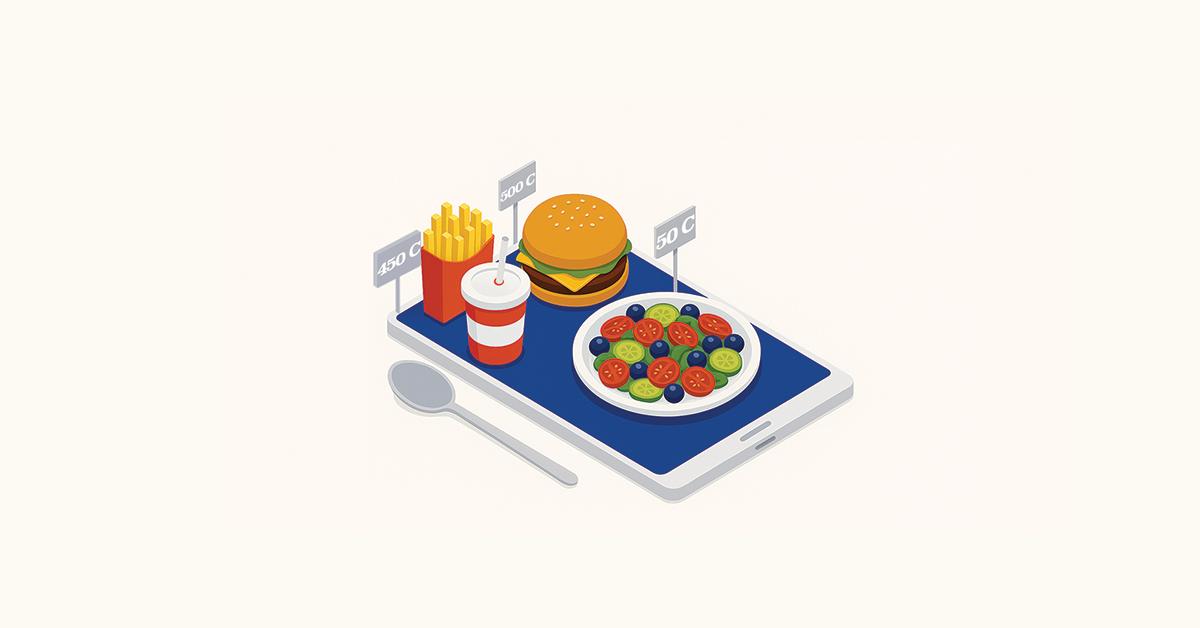
Imagine a world where tracking daily calorie intake is as simple as taking a picture. No manual entries. No confusing calculations. Just a quick snap of a meal, and the app does the rest. This is exactly what AI-powered photo calorie counter apps like CalAI bring to the table, making healthy eating more accessible and effortless.
With the UAE’s growing focus on health and wellness, the demand for smart nutrition solutions is at an all-time high. Consumers are looking for technology that seamlessly integrates into their lifestyles, and businesses are exploring new ways to cater to this need. If you’re an entrepreneur in the UAE looking to build the next big thing in health tech, developing a photo calorie tracking app could be your gateway to success.
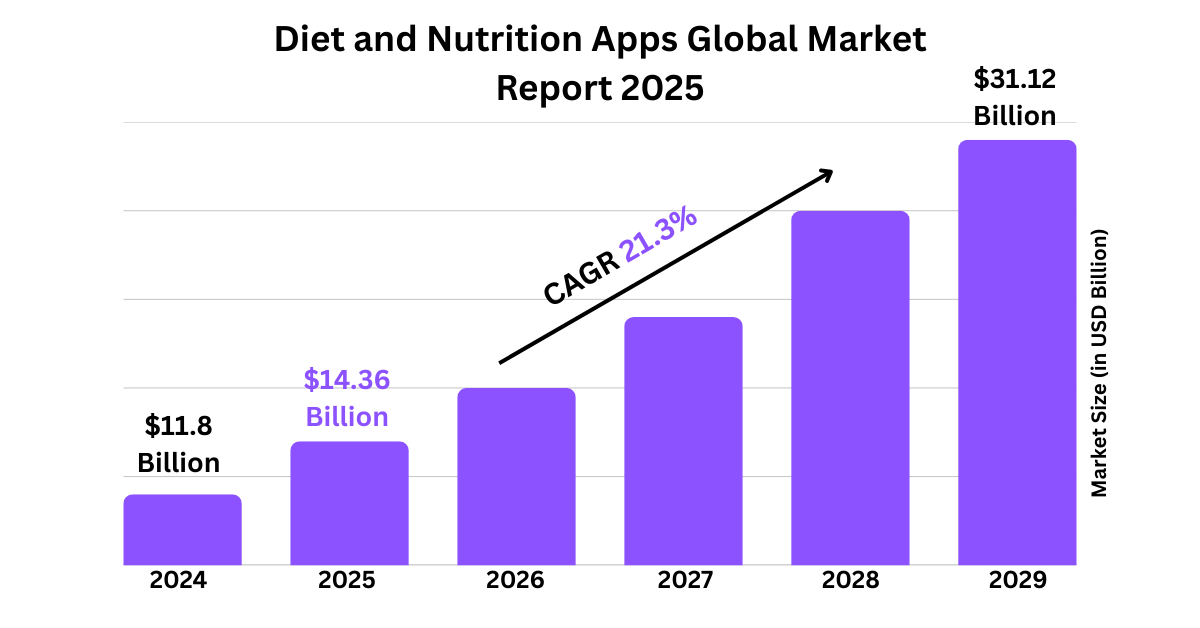
But where do you start? What makes an app like CalAI work so efficiently? In this guide, we break down everything you need to know – from the core intent behind using AI nutrition apps to the essential features, challenges, and market opportunities. Let’s dive in.
What Users Expect from a Photo Calorie Tracking App
The growing interest in health-conscious lifestyles has led to a rising demand for photo calorie tracking apps. Users are no longer satisfied with just basic calorie counting; they expect a comprehensive tool that fits seamlessly into their daily routine, provides valuable insights, and adapts to their individual health goals. Understanding these expectations is crucial for the calorie counting app development that stands out in the competitive health tech market.
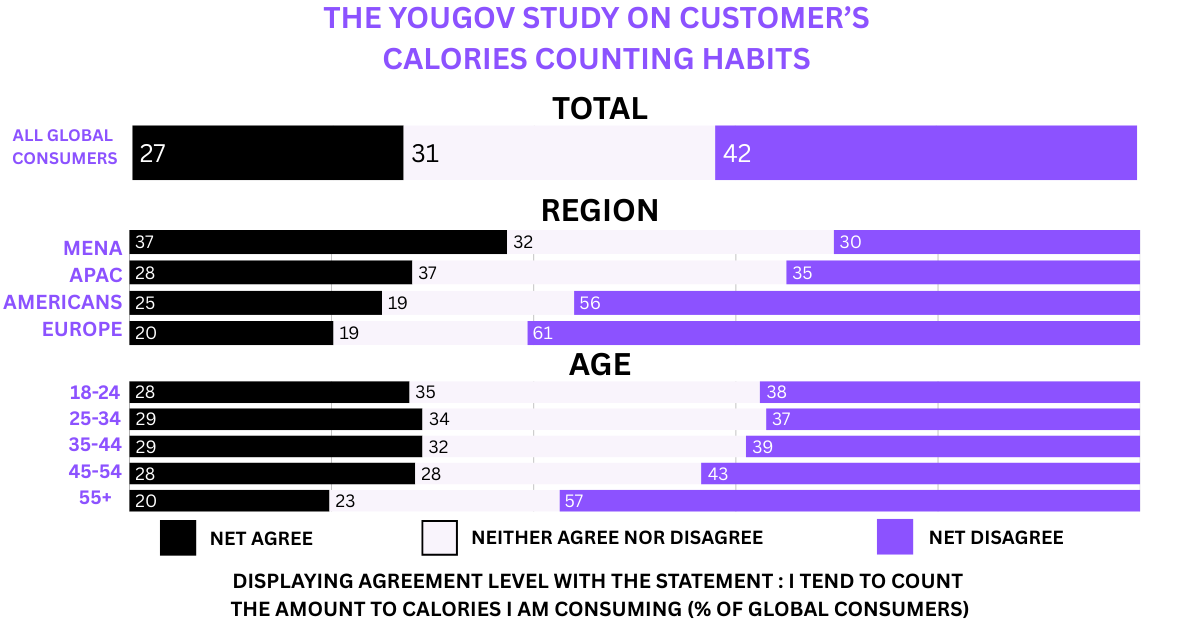
Seamless User Experience
Users want a hassle-free way to track their meals without manually entering every ingredient. A well-designed app should allow quick and effortless food logging through photo recognition while maintaining an intuitive interface. Apps like SnapCalorie simplify this process by letting users take a picture or record a voice note, with AI instantly analyzing the meal’s nutritional value. However, usability extends beyond just taking photos. Users expect smooth navigation, clear visual representations of data, and a frictionless experience across different devices.
Accuracy and Reliability
The biggest challenge for AI-driven food tracking is accuracy. Users rely on these apps to make informed dietary decisions, so miscalculations in calorie estimates or incorrect food identification can lead to misleading health outcomes. Studies have found that AI-based photo calorie app development often struggle with estimating portion sizes correctly, especially for mixed dishes. For instance, research evaluating MyFitnessPal and Foodvisor showed significant discrepancies in calorie estimations for meals containing multiple ingredients. Developers need to invest in advanced AI training, larger food databases, and user verification methods to enhance reliability.
Personalization and Goal Setting
One-size-fits-all solutions don’t appeal to modern users who expect customized recommendations based on their dietary preferences, activity levels, and health goals. A successful app should allow users to set personalized calorie targets, track macronutrients, and adjust plans according to weight management or fitness objectives. Platforms like MyNetDiary stand out by offering individualized diet plans and AI-driven coaching tailored to user habits. This level of personalization helps users stay engaged and achieve better results.
Feedback and Insights
Simply displaying calorie counts is not enough – users want meaningful feedback on their eating habits. A valuable app should provide nutritional insights, trend analysis, and suggestions for healthier food choices. MacroFactor, for instance, not only tracks calorie intake but also offers real-time metabolic adjustments based on user progress. Advanced analytics and AI-driven insights can help users make better food decisions and maintain long-term dietary discipline.
Integration with the Broader Health Ecosystem
A calorie tracking app does not function in isolation; users expect it to sync seamlessly with fitness trackers, smartwatches, and other health platforms. Integration with Apple Health, Google Fit, and wearable devices like Fitbit or Garmin enhances the user experience by providing a holistic view of their nutrition, exercise, and overall health metrics. MyFitnessPal is known for its robust integrations, allowing users to sync their food logs with exercise data to get a complete picture of their daily energy balance.
Privacy and Data Security
Given the sensitive nature of health data, users are increasingly concerned about how their personal information is stored and used. They expect clear privacy policies, secure data storage, and control over what information they share. The 2018 MyFitnessPal data breach, which exposed the accounts of 150 million users, highlighted the importance of strong cybersecurity measures. Developers must implement end-to-end encryption, secure cloud storage, and transparent data usage policies to build trust among users.
Cultural Sensitivity and Localization
When you build an app like CalAI expecting it to succeed in a diverse market like the UAE, it must cater to regional dietary habits and food preferences. Many calorie tracking apps are built around Western food databases, making them less effective for users in the Middle East, Asia, or Africa. HealthifyMe has expanded its offerings by mapping regional foods and supporting multiple languages, making it more relevant to users outside of North America and Europe. A successful app in the UAE must recognize traditional dishes, account for local portion sizes, and provide meal recommendations aligned with cultural preferences.
Community and Social Engagement
Many users stay motivated when they are part of a supportive community. Social engagement features in food calorie tracking apps such as group challenges, shared meal logs, and achievement badges can help sustain long-term app usage. Lose It! encourages community participation by allowing users to join groups, share progress, and compete in friendly challenges. These social elements add an interactive layer that turns meal tracking into a more engaging and rewarding experience.
Users expect a photo calorie counter app to be more than just a digital food diary. It should be highly accurate, seamlessly integrated with their existing health tools, personalized to their needs, and culturally inclusive. Addressing these expectations will help developers create an app that not only tracks calories efficiently but also provides meaningful health insights and fosters long-term user engagement.
Essential Features for a Photo Calorie Tracking App
A calorie-tracking app should do more than just count calories, it should act as a personalized nutrition coach, offering deep insights into food choices, exercise balance, and health trends. Below are the key features of a photo calorie counter app that can enhance accuracy, user engagement, and long-term adherence to health goals.
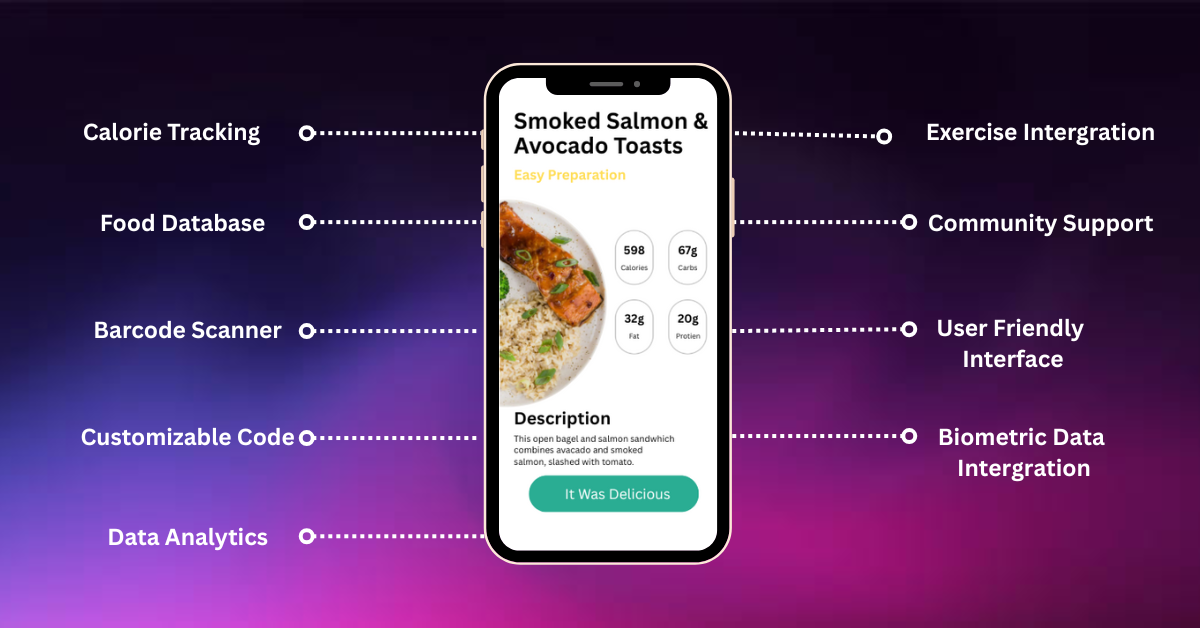
1. Exercise Logging for a Comprehensive Health Overview
Calorie tracking is only half the equation. Users also need to log their physical activity to understand their net calorie balance. The best calorie counter app should support manual entry of workout details, integration with fitness trackers like Apple Health or Fitbit, and automatic syncing with wearable devices. Advanced AI-based tracking could even estimate calorie burn based on movement patterns captured through a smartphone’s sensors.
2. AI-Powered Food Recognition Through Photos for Instant Logging
One of the most transformative features is the ability to snap a picture of a meal and receive an automatic calorie estimate. AI models trained on vast food datasets can identify ingredients, portion sizes, and even preparation methods. Companies like SnapCalorie have pioneered this approach, reducing the need for tedious manual input.
3. Smart Food Label Scanning for Effortless Nutrient Tracking
Users consuming packaged foods often struggle with entering detailed nutritional data. A label scanner extracts key information, calories, macronutrients, additives, directly from packaging, making tracking seamless. MacroFactor successfully employs this feature, allowing for near-instant meal logging.
4. Barcode Scanning for Fast and Accurate Logging
With a simple barcode scan, users can pull up a food item’s full nutritional breakdown from a centralized database. This eliminates the hassle of searching for or estimating calorie counts manually. FatSecret’s calorie counter integrates this feature, enabling users to scan thousands of products instantly.
5. Manual Food Description Entry for Personalized Logging
Not all meals can be recognized through AI or barcodes. Users should be able to manually input meal details, including ingredients, portion sizes, and cooking methods. This is particularly useful for homemade dishes or regional cuisine that might not be present in global food databases.
6. Health Score for a Simplified Nutritional Summary
Instead of focusing solely on calorie intake, a health score system evaluates meals based on overall nutrition. The photo calorie counter app development process can be planned to assess macronutrient balance, fiber intake, processed food content, and other key factors, providing users with an easy-to-understand rating. This feature ensures that users prioritize food quality over just calorie counting.
7. Personalized Diet and Exercise Recommendations for Smarter Choices
An effective calorie tracker should do more than record data, it should provide actionable insights. AI-powered recommendations based on user history, health goals, and dietary preferences can suggest meal ideas, portion adjustments, and even suitable workouts. MyFitnessPal food calorie tracker has successfully integrated such personalized advice.
8. Goal Tracking with Progress Visualization
Tracking progress toward a goal – whether weight loss, muscle gain, or balanced nutrition – keeps users engaged. The calorie tracking app should provide progress graphs, milestone achievements, and motivational prompts to help users stay committed.
9. Customizable Nutritional Metrics for User-Specific Needs
While some users focus on calorie intake, others may prioritize protein for muscle building, fiber for gut health, or micronutrient intake for balanced nutrition. The app should allow customization, enabling users to track the specific metrics most relevant to their health goals.
10. AI-Based Meal Planning for Simplified Nutrition Management
Many people struggle with planning meals that meet their dietary goals. An AI-driven meal planner can suggest recipes based on caloric requirements, available ingredients, and personal preferences, reducing decision fatigue and ensuring balanced eating.
11. Integration with Wearable Devices for Real-Time Health Insights
By syncing with wearables like Apple Watch, Fitbit, and Garmin, the app can pull in real-time activity data, automatically adjust calorie budgets, and provide a holistic view of daily energy balance. This integration removes the need for manual data input, increasing user convenience.
12. Social Sharing and Community Support for Accountability
Engagement is higher when users feel a sense of community. Features like social challenges, group discussions, and progress-sharing capabilities can motivate users to stay on track. Community-driven platforms, such as Noom, have leveraged peer support to boost user retention.
By combining these intelligent features, a photo calorie tracking app can provide not only a seamless logging experience but also personalized insights that empower users to make healthier choices.
Designing a User-Centric Photo Calorie Tracking App
Creating an intuitive and visually appealing calorie-tracking app requires more than just sleek aesthetics, it demands a thoughtful approach to usability, accessibility, and user engagement. A well-designed photo calorie app like CalAI should seamlessly guide users through meal logging, insights, and goal tracking without friction. Below is a structured approach to designing a photo calorie-tracking app that prioritizes user experience.
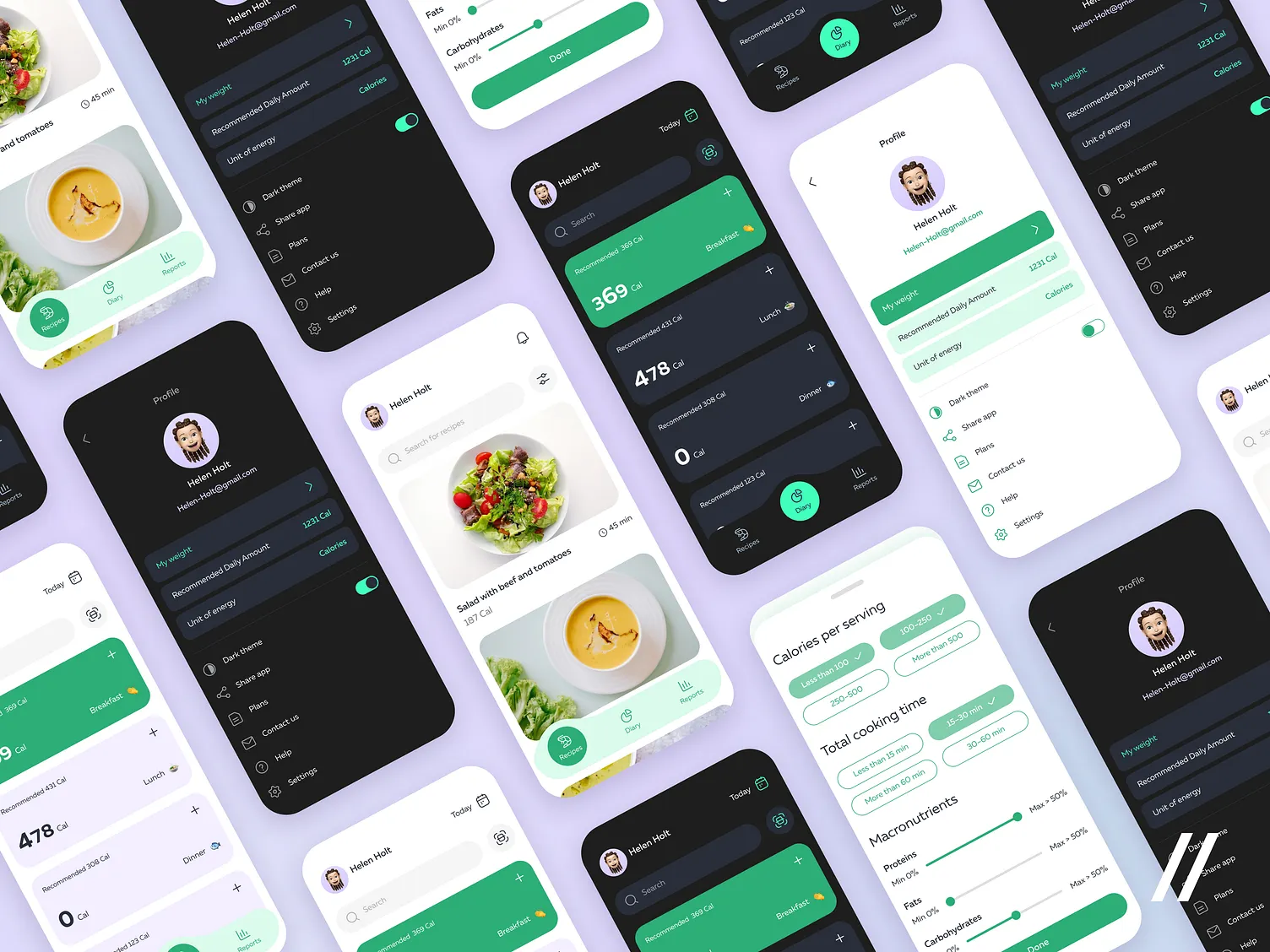
1. Prioritizing a Clean and Minimalist Interface
Users interact with a calorie-tracking app multiple times a day, so the design must be clutter-free and easy to navigate. A clean layout with a balanced color palette and well-defined typography enhances readability and usability. Avoid excessive visual elements that could overwhelm users, focus on a streamlined design that highlights essential functions like meal logging, calorie insights, and progress tracking.
2. Ensuring Effortless Navigation with Intuitive UI
A clear, logical flow is crucial. Users should be able to log meals with minimal steps, access reports easily, and switch between features without confusion. Consider:
- A bottom navigation bar for primary actions like home, scan, history, and settings.
- A floating action button (FAB) for quick photo-based meal logging.
- A swipeable interface for seamless transitions between screens.
3. Designing an Engaging Onboarding Experience
First impressions matter. A well-structured onboarding process of the photo calorie counter app should:
- Showcase core features with visual demonstrations.
- Ask relevant preferences (e.g., dietary goals, tracking priorities).
- Offer a guided first-use experience, walking users through their first meal log.
4. Creating a Visually Intuitive Food Recognition Flow
Since the app relies heavily on photo-based calorie tracking, the scanning and recognition flow must be seamless:
- A large, clearly visible camera button to encourage photo-based logging.
- Real-time feedback during scanning (e.g., detecting items, showing calorie estimates live).
- Editable recognition results so users can refine detected food items easily.
5. Using Visual Hierarchy for Readability and Clarity
Every screen should direct the user’s attention effectively. Implement:
- Bold headings for key sections (e.g., calorie summary, meal breakdown).
- Contrasting colors for action buttons (e.g., logging meals, saving data).
- Clear data visualization (graphs, progress bars) to simplify calorie insights.
6. Prioritizing Accessibility and Inclusivity
The design should cater to users of all backgrounds, including those with disabilities. Consider:
- High-contrast text and buttons for readability.
- Support for dark mode to reduce eye strain.
- Voice input options for users who prefer hands-free logging.
- Localized UI to adapt to different languages and cultural dietary preferences.
7. Leveraging Data Visualization for Progress Tracking
Numbers alone don’t always motivate users – visual elements do. Incorporate:
- Color-coded progress graphs to track calorie intake trends.
- Circular progress indicators for goal completion.
- Before-and-after meal comparisons to illustrate healthier choices over time.
8. Incorporating Micro-Interactions for a Dynamic UX
Small animations and subtle haptic feedback can enhance user experience without being intrusive. Examples include:
- A success animation when logging a meal to reinforce a sense of achievement.
- A gentle vibration on incorrect input to guide users without frustration.
- Smooth transitions when switching between screens for a fluid experience.
Designing a successful photo calorie-tracking app requires a deep focus on user behavior, simplicity, and engagement. By ensuring intuitive navigation, accessible features, and visually compelling insights, your app can become a seamless part of users’ health journeys.
Developing a Photo Calorie Tracking App – Key Stages and Possible Challenges
Building a photo calorie-tracking app requires a structured approach, integrating AI-powered food recognition, seamless user experience, and secure data management. Below is a step-by-step breakdown of how to build an AI calorie counter app like CalAI, along with common challenges and solutions.
1. Defining Requirements and Setting Goals
The first step involves outlining the app’s objectives, user expectations, and core functionalities. This includes:
- Selecting primary features (photo-based logging, AI recognition, meal tracking).
- Defining app scalability (handling large image datasets, real-time processing).
- Ensuring regulatory compliance (GDPR, UAE data privacy laws).
Challenge: Balancing feature richness with simplicity.
Solution: Prioritize a minimal viable product with essential features first, refining based on user feedback.
2. Designing the System Architecture
The backend should support high-speed image processing and data storage while ensuring security. The key considerations are:
- Cloud-based storage for food images and nutritional data.
- Scalable infrastructure to handle increasing user demands.
- AI and machine learning integration for accurate food recognition.
Challenge: Maintaining speed without compromising accuracy.
Solution: Optimize AI models for faster processing while using caching for frequently logged foods.
3. Implementing AI-Based Food Recognition
The core of the app lies in AI-powered image processing. Steps include:
- Training machine learning models on a diverse food dataset for better recognition.
- Using image segmentation and deep learning to identify food portions and types.
- Allowing manual corrections to improve AI accuracy over time.
Challenge: Recognizing diverse cuisines, especially Middle Eastern dishes.
Solution: Train AI models with region-specific datasets and user-submitted corrections.
4. Developing the Frontend and User Interface
The app’s frontend should be intuitive, engaging, and responsive. Focus areas include:
- A smooth camera interface for quick food scanning.
- Real-time feedback for recognized food items.
- Interactive dashboards for tracking progress visually.
Challenge: Ensuring seamless user experience across devices.
Solution: Use cross-platform frameworks like Flutter or React Native for consistent performance.
5. Data Security and Privacy Implementation
Since users log personal dietary data, strong security measures are essential. This includes:
- End-to-end encryption for food logs and health data.
- Anonymous data processing to prevent personal information exposure.
- Explicit user consent mechanisms for data sharing.
Challenge: Meeting UAE-specific privacy regulations.
Solution: Adhere to local laws and provide clear privacy policies with user opt-in choices.
6. Testing and Quality Assurance
Comprehensive testing ensures the app functions smoothly under real-world conditions. Key tests include:
- AI accuracy testing to validate food recognition.
- Performance testing for smooth app functioning under heavy loads.
- Usability testing with real users for feedback-driven improvements.
Challenge: Avoiding AI biases in food recognition.
Solution: Continuously update models with diverse food entries from various demographics.
7. Deployment and Post-Launch Improvements
Once testing is complete, the app is launched on platforms like iOS and Android. Post-launch efforts include:
- Collecting user feedback to refine AI and UX.
- Rolling out regular updates for improved accuracy and features.
- Monitoring performance analytics to optimize app efficiency.
Challenge: User retention beyond initial downloads.
Solution: Introduce engaging features like gamification, progress rewards, and personalized insights.
Developing a photo calorie tracking app is a multi-phase journey requiring careful planning, AI-driven precision, and ongoing refinement. Overcoming challenges such as food recognition accuracy, data security, and user engagement ensures long-term success in the UAE’s health-conscious market.
Cost of Developing a Photo Calorie-Tracking App in the UAE
The development cost to develop a photo calorie counter app in the UAE depends on its complexity, with factors like AI sophistication, third-party integrations, and security measures influencing the budget. Here’s a breakdown based on three development tiers:
1. Basic App Development (AED 150,000 – AED 250,000)
A simple food calorie tracking app with food photo scanning, manual entry, and basic calorie estimation falls into this category. The cost covers:
- A user-friendly mobile app (iOS and Android)
- Basic food recognition AI
- Essential goal-setting and progress tracking
- Secure cloud-based backend for data storage
- Simple UI/UX without advanced animations
This is ideal for startups looking to launch an MVP with core functionalities.
2. Mid-Tier App Development (AED 300,000 – AED 600,000)
A more advanced version with improved AI accuracy, third-party integrations, and personalization features requires additional investment. The budget accounts for:
- AI-driven food recognition with better accuracy
- Barcode and nutrition label scanning
- Integration with wearables (Apple Health, Google Fit)
- Personalized diet recommendations based on user goals
- Localization for UAE, including Arabic language support and regional food databases
- Secure data handling with UAE compliance regulations
This level suits businesses aiming for a competitive, feature-rich product tailored to the UAE market.
3. Complex AI-Powered App Development (AED 700,000 – AED 1,200,000+)
High-end, AI-driven calorie counting app development with full automation, predictive analytics, and social engagement features falls into this range. It includes:
- Advanced machine learning for precise food recognition, including regional cuisines
- AI-driven adaptive goal tracking based on health trends
- Social features like meal sharing, expert consultations, and community challenges
- Gamification elements to increase engagement
- Multi-device compatibility, including smartwatches and home assistants
- Enterprise-grade security and compliance with UAE data privacy laws
This tier is best suited for enterprises and investors looking to create a market-leading solution that scales across the GCC region.
The UAE’s development costs are generally higher due to localization, compliance, and the need for premium security measures. Companies can optimize budgets by starting with an MVP, outsourcing AI model development, or implementing features in phases.
Ensuring a Competitive Edge in the UAE Market
Photo calorie counter app development requires more than just AI-driven food recognition, it needs a strong monetization strategy, accurate tracking, cultural relevance, and seamless integration with health ecosystems. Here’s how to stand out in a competitive market.
1. Monetization Strategies for Sustainable Growth
Most calorie-tracking apps rely on premium subscriptions, but diversifying revenue streams can make an app more sustainable. Introducing pay-per-feature options, such as personalized meal plans or expert consultations, allows users to pay for only what they need. Partnering with UAE-based fitness centers, nutritionists, and health product brands can also open new revenue opportunities while enhancing user experience.
Additionally, offering a white-label version of the app to gyms, wellness programs, and corporate health initiatives can create a B2B income stream. A well-balanced mix of premium plans, microtransactions, and strategic partnerships ensures profitability without compromising accessibility.
2. Enhancing AI Accuracy for Better User Trust
One of the biggest challenges in AI nutrition apps is the accuracy of food recognition, especially when identifying regional dishes and mixed meals. Training AI models with region-specific datasets improves precision, ensuring the app recognizes Middle Eastern cuisines and local food brands. Crowdsourced data validation, where users can submit corrections, refines AI models over time, making them more reliable.
For users seeking higher accuracy, offering an optional expert-verified food database can add an extra layer of trust. Combining AI with user input and expert oversight enhances the credibility of calorie estimations and nutritional insights.
3. Personalization and Adaptive Goal Tracking
A common limitation in existing apps is the lack of adaptive goal-setting that evolves with the user’s progress. AI-powered dynamic goals that adjust calorie and macro targets based on real-time activity levels and health trends can offer a more personalized experience.
Context-aware recommendations, such as modifying meal plans for Ramadan fasting schedules or local dietary habits, further refine personalization. Integrating expert-validated diet plans alongside AI suggestions ensures that users receive a balanced mix of automation and professional guidance.
4. Seamless UAE-Specific Localization
To succeed in the UAE market, an app must go beyond basic translation and offer culturally relevant features. Arabic language support should be fully integrated, including meal names, app navigation, and food descriptions. Recognizing halal food categories, integrating a fasting mode for Ramadan, and adjusting meal timing recommendations to fit local routines can make the app more intuitive for users. Localization efforts should extend beyond language and consider dietary customs, religious practices, and food availability to create a truly user-centric experience.
5. Community Engagement and Social Features
Many calorie counter apps struggle with user retention due to a lack of social engagement. Introducing challenge-based gamification, such as daily streaks and leaderboard competitions, can keep users motivated. In-app support from dietitians, whether through live chat or AI-driven recommendations, fosters a sense of guidance and accountability. A social meal-sharing feature, where users can log and discuss meals within private or public groups, can create a stronger sense of community. Encouraging user interaction through challenges, expert support, and social sharing can turn calorie tracking from a solo activity into a more engaging experience.
6. Expanding Integration with Wearables and Health Apps
Seamless integration with broader health ecosystems enhances the app’s utility. Syncing with smartwatches, fitness bands, and health platforms like Apple Health and Google Fit enables more accurate activity tracking. AI-driven insights based on wearable data, such as adjusting calorie recommendations based on step count and heart rate, can provide a more holistic approach to health tracking. Expanding integrations to include grocery delivery apps or restaurant menus can further streamline meal planning and food logging.
A successful calorie tracking app in the UAE must combine AI precision, cultural sensitivity, and seamless user engagement. By focusing on monetization strategies, localization, personalization, and ecosystem integration, developers can create a standout product that not only tracks calories but enhances the overall wellness journey.
How CodingWorkx Can Help Build a Market-Leading Photo Calorie-Tracking App
At CodingWorkx, we specialize in developing AI-powered health and wellness applications tailored to the UAE market. With deep expertise in machine learning, computer vision, and mobile app development, we create calorie-tracking solutions that offer seamless user experiences, high accuracy, and strong data security. Our team understands the complexities of integrating advanced food recognition AI, ensuring that regional cuisines are well-represented for precise calorie estimations. We also focus on scalability, allowing businesses to start with an MVP and expand with more sophisticated features over time.
Beyond technology, our team ensures compliance with UAE data privacy regulations, incorporating robust security frameworks to protect user data. We design intuitive, multilingual interfaces that cater to both Arabic and English-speaking users, making the app more accessible to a diverse audience. Our expertise extends to integrating wearables, cloud-based analytics, and AI-driven meal recommendations, enhancing the overall functionality of the application. Whether it’s optimizing AI models for improved food recognition, implementing engaging social features, or refining user experience with a sleek and responsive interface, we provide end-to-end development support.
Partnering with us means access to a dedicated team that not only builds a high-performance app but also ensures long-term success through continuous updates, AI refinements, and feature expansions. A team that leverages the latest in health tech innovations to help businesses create competitive, future-ready solutions that stand out in the UAE’s growing digital fitness landscape.
FAQs.
Q. What is a photo calorie app, and how does it work?
A photo food calorie tracker app is an AI-powered nutrition tracker that estimates the calories and nutrients in a meal based on a photo taken by the user. Using computer vision and deep learning, the app analyzes food images, identifies ingredients, and calculates nutritional values. Some apps also incorporate barcode scanning, manual entry, and database integration to enhance accuracy.
Q. What features should a calorie-tracking app have?
A well-rounded photo calorie app like CalAI should include AI-powered food recognition, barcode and nutrition label scanning, personalized goal setting, progress tracking, meal recommendations, integration with wearables, and multilingual support. Additional features like gamification, community engagement, and expert consultations can enhance user experience and retention.
Q. How much does it cost to develop a photo calorie app?
The cost depends on the app’s complexity. A basic version with essential features may cost AED 150,000 – AED 250,000, a mid-tier app with AI enhancements and third-party integrations can range from AED 300,000 – AED 600,000, while a fully-featured AI-driven app with advanced analytics and social features may cost AED 700,000 – AED 1,200,000+. Factors like AI training, security compliance, and regional localization also impact the final budget.
Q. What technologies are used in AI-powered calorie apps?
These apps leverage computer vision for image recognition, deep learning models (such as convolutional neural networks) for food classification, and natural language processing for voice and text-based logging. They integrate cloud computing for real-time processing, APIs for nutrition databases, and mobile development frameworks like Flutter, React Native, or native iOS/Android for cross-platform accessibility.
Q. What are the benefits of using AI in nutrition apps?
AI enhances accuracy, automates food logging, and personalizes nutrition plans based on user preferences. It reduces manual entry effort, provides real-time insights, and adapts recommendations based on dietary habits. AI also improves meal portion estimation and enables smarter tracking, making calorie management more efficient and user-friendly.
Q. How long does it take to build a calorie-tracking app?
Development time varies based on feature complexity. A basic version of photo calorie counter app development can take 4-6 months, a mid-range app with AI enhancements may take 6-10 months, while a high-end solution with extensive integrations and machine learning refinements can take 12+ months. Factors like AI training, regulatory approvals, and iterative testing influence overall timelines.


